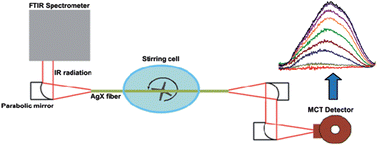 Take a look at this HOT paper from Editorial Board member Boris Mizaikoff.
Take a look at this HOT paper from Editorial Board member Boris Mizaikoff.
Water is a common contaminant in industrial oils and petroleum products. It impairs the performance and longevity of machinery, so it’s important to detect it in these products. A previous approach has involved off-site analysis, but this method is time consuming and may be compromised because of the potential variability in water concentration introduced by storage, transportation or shipment of a sample.
Here, Professor Mizaikoff and colleagues have focused on quantifying trace amounts of water in hydrocarbons using hexane as a model system for industrial oils and petroleum using mid-infrared evanescent field absorption spectroscopy.
They used a silver halide fibre optic waveguide to interrogate in situ water-in-hexane emulsions. The limits of detection and limits of quantification of water in hexane using tin-crosslinked polyacrylic acid modified fibres were 76 and 170ppm, respectively. The IR absorption signature of water in hexane was detected at concentrations as low as 10ppm.
The strategy requires a single measurement, requires no sample preparation and has the potential for direct in situ detection.
Detecting trace amounts of water in hydrocarbon matrices with infrared fiberoptic evanescent field sensors
Yuliya Luzinova, Bogdan Zdyrko, Igor Luzinov and Boris Mizaikoff
Analyst, 2012, Advance Article
DOI: 10.1039/C1AN15521K
Take a look at some of Boris’ other recent work:
Nitrogen-doped diamond-like carbon as optically transparent electrode for infrared attenuated total reflection spectroelectrochemistry
Nicola Menegazzo, Markus Kahn, Roswitha Berghauser, Wolfgang Waldhauser and Boris Mizaikoff
Analyst, 2011, 136, 1831-1839
DOI: 10.1039/C0AN00503G
Communication: Surface-modified ZnSe waveguides for label-free infrared attenuated total reflection detection of DNA hybridization
Carla S. Riccardi, Dennis W. Hess and Boris Mizaikoff
Analyst, 2011, 136, 4906-4911
DOI: 10.1039/C0AN00504E
Don’t forget that Boris is our Associate Editor for Europe. If you are a European author, why not submit your next paper to his office?











